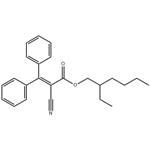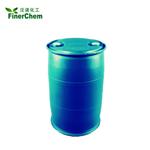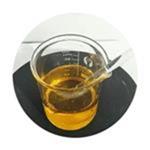- Octocrylene
-

- $0.00 / 1kg
-
2024-08-30
- CAS:6197-30-4
- Min. Order: 0.10000000149011612kg
- Purity: ≥99%
- Supply Ability: 20tons
- Octocrilene
-

- $5.00 / 200KG
-
2024-08-30
- CAS:6197-30-4
- Min. Order: 1KG
- Purity: 99%
- Supply Ability: 1000mt/year
- Octocrylene
-

- $6.00 / 1kg
-
2024-08-30
- CAS:6197-30-4
- Min. Order: 1kg
- Purity: 99%
- Supply Ability: 2000KG/Month
|
| | Octocrylene Chemical Properties |
| Melting point | -10 °C (lit.) | | Boiling point | 218 °C/1.5 mmHg (lit.) | | density | 1.051 g/mL at 25 °C (lit.) | | vapor pressure | 0Pa at 25℃ | | refractive index | n20/D 1.567(lit.) | | Fp | >230 °F | | storage temp. | 15-25°C | | solubility | Chloroform (Slightly), Methanol (Sparingly) | | form | Oil | | color | Colourless to Light Yellow | | Merck | 14,6756 | | InChIKey | FMJSMJQBSVNSBF-UHFFFAOYSA-N | | LogP | 6.1 at 23℃ | | CAS DataBase Reference | 6197-30-4(CAS DataBase Reference) | | EPA Substance Registry System | 2-Ethylhexyl 2-cyano-3,3-diphenylacrylate (6197-30-4) | | Absorption | uv max: 303 nm |
| Risk Statements | 52 | | Safety Statements | 29/56 | | WGK Germany | 1 | | RTECS | UD3328750 | | HS Code | 29269095 | | Toxicity | LD50 orl-rat: >5 g/kg NTIS** OTS0556792 |
| | Octocrylene Usage And Synthesis |
| Environmental pollution | Octocrylene has been found in various environments, not least those of swimming pools, where it is evidently released by consumers to the point that it is now considered an emerging micropollutant similar to poly-fluoroalkyl substances (PFAS), blue-green algae, toxic fungal products, hormones, psychoactive drugs, pesticides, cosmetics, and industrial additives and drugs. These substances, unlike conventional and unconventional pollutants, are still largely unregulated by legislation and are not restricted by maximum permitted values. Furthermore, they are potentially dangerous for the environment and human health, even in an overall context of insufficient data linked to their dangerousness[1]. | | carcinogenicity |
Octocrylene readily absorbs through the skin at levels about 14 times the FDA cutoff for systemic exposure. Octocrylene has been linked to aquatic toxicity, potentially harming coral health. The study suggests that octocrylene can break down to form a substance called benzophenone, which may lead to cancer. According to one study, benzophenone levels can increase in products over time. The European Commission recently concluded that although there was some evidence of octocrylene’s hormone-disrupting potential, current use concentrations of up to 10 percent were considered safe.
| | Description | Octocrylene (OCT) is a viscous, clear, colorlesss oi introduced in commercial sunscreens and anti-ageing creams about 15 years ago. It is the 2-ethylhexyl ester of 2-cyano-3,3-diphenylacrylic acid, with the extended conjugation of the acid portion that absorbs UVB and short-wave UVA (ultraviolet) rays, with wavelengths from 280 to 320 nm, which promote tanning but also contribute to the onset of sunburn and skin cancer. It is used in various body care products, in concentrations up to 10%, to provide an adequate sun-protection factor or to protect the body care formulations themselves from UV radiation[1]. | | Chemical Properties | Clear yellow viscous liquid with mild characteristic odor, Miscible in methanol, n-butanol, ethyl acetate, mineral oil, hexane, toluene. Immiscible in water. Octocrylene is an effective oil soluble liquid UV‐B filter. It has excellent dissolving properties for crystalline UV filters. | | Uses | Octocrylene is an ingredient used in sunscreens for its ability to absorb UV rays, protecting the skin from sun damage. It is chemically related to cinnamates. It can be used to boost SPF and improve water resistance in a given formulation. Octocrylene is photostable and can improve the photostability of other sunscreens. It is expensive and can present difficulties in formulation. | | Application | octocrylene is a uVB sunscreen with strong water-resistant properties and a rather broad-band absorption range. It exhibits good photostability, and is being evaluated by many companies as an effective SPF booster and waterproofing enhancer. This is an expensive ingredient with an approved usage level of 7 to 10 percent in both the united States and the european union. Although gaining in popularity among formulators, its cost and usage level can limit use. In addition, some studies are indicating it may cause allergic reactions in skin with a history of photoallergy. | | Definition | ChEBI: Octocrylene is a diarylmethane. It is an ester formed by the condensation of a diphenylcyanoacrylate with 2-ethylhexanol, used in sunscreens and cosmetics. | | benefits | Octocrylene is a compound often used as an additive in sun screen, and is thought to have skin moisturizing effects because of its emollient properties. What makes this chemical such a popular additive to sun block, is its ability to neutralize UV radiation dissipated by sunlight, and to minimize skin damage from prolonged sun exposure. Octocrylene protects the skin from the harmful effects of the sun and premature skin aging. It helps prevent the risk of skin cancer. This filter mainly absorbs UVB rays, and shorter UVA rays, which are responsible for aging but also for skin cancer. | | General Description | Yellow viscous liquid. Insoluble in water. | | Air & Water Reactions | Insoluble in water. | | Reactivity Profile | Octocrilene is an ester derivative. Esters react with acids to liberate heat along with alcohols and acids. Strong oxidizing acids may cause a vigorous reaction that is sufficiently exothermic to ignite the reaction products. Heat is also generated by the interaction of esters with caustic solutions. Flammable hydrogen is generated by mixing esters with alkali metals and hydrides. | | Fire Hazard | Flash point data for Octocrilene are not available. Octocrilene is probably combustible. | | Flammability and Explosibility | Non flammable | | Contact allergens | Octocrylene is an anti-UVB filter used in cosmetics
that may induce photoallergic contact dermatitis. | | Side effects | Some people are concerned about the body’s ability to absorb octocrylene, which can present in the blood, urine, and breast milk. It may promote the production of free radicals, which can damage DNA, potentially increasing the risk of melanoma. However, further research is necessary.
People with sensitive skin or skin conditions, such as eczema, may prefer to avoid products containing octocrylene. Alternatively, a person can perform a patch test before using a product containing octocrylene for the first time. The patch test should indicate if an individual is allergic or sensitive to an ingredient in the product.
The Food and Drug Administration (FDA) evaluated the safety of octocrylene for use in sunscreen products and found that concentrations of up to 10% are safe.
The European Scientific Committee on Consumer Safety (SCCS) also stated that octocrylene is safe in products containing concentrations of no more than 10%.
Berardesca, E.,et al.(2019). Review of the safety of octocrylene used as an ultraviolet filter in cosmetics.
https://onlinelibrary.wiley.com/doi/full/10.1111/jdv.15945 | | Safety Profile | Low toxicity by ingestion. Whenheated to decomposition it emits toxic vapors of NOx. | | References | [1] Antonio Medici. “Octocrylene: From Sunscreens to the Degradation Pathway during Chlorination Processes: Formation of Byproducts and Their Ecotoxicity Assessment.” Molecules (2022). |
| | Octocrylene Preparation Products And Raw materials |
|